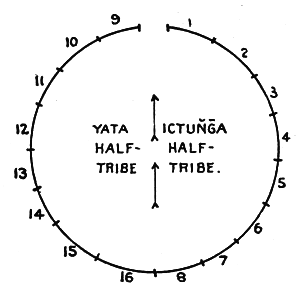| < THE QUAPAW OR KWAPA | Main Contents | THE OSAGE > |
THE KANZE OR KANSA
Among the Omaha the Yata people are those who camp on the yata or left side of the tribal circle; the Ictŭñga people, those who camp on the ictŭñga or right side.
The tribe is divided into seven phratries, or, as the Kansa style each, wayuⁿmiⁿdaⁿ, (i.e., those who sing together), as follows:| Phratries | Gentes | Subgentes |
|---|---|---|
| I | 1. Maⁿyiñka, Earth, or Maⁿyiñka gaxe, Earth-lodge-makers. | a, Maⁿyinka tañga, Large earth. b, Maⁿyiñka jiñga, Small earth. |
| II | 2. Ta, Deer, or Wajaje, Osage. | a, Taqtci, Real deer. b, Ta, yatcajĭ, Eats-no-deer, or Ta ts‘eyĕ, Kills-deer, or Wadjüta ts‘eyĕ, Kills-quadrupeds. |
Page 231
| Phratries | Gentes | Subgentes |
|---|---|---|
| III | 3. Pañka, Ponka | a, Pañk unikaciⁿga, Ponka people. b, Qŭndj-alaⁿ, Wear-red-cedar (-fronds)-on-their-heads. |
| III | 4. Kanze, Kansa, or Tci hacin, Lodge-in-the-rear; Last-lodge. | a, Tadje unikaciⁿga, Wind people, or Ak‘a unikaciⁿga, South-wind people, or Tci haciⁿqtci, Real Tci haciⁿ, Camp-behind-all. b, Tadje jiñga, Small-wind, or Maⁿnaⁿhindje, Makes-a-breeze-near-the-ground. |
| III | 5. Wasabe, Black bear. | a, Wasabĕqtci, Real Black-bear, or Sakŭⁿ wayatce, Eats-raw (-food). b, Sindjalĕ, Wear-tails (locks of hair)-on-the-head. |
| I | 6. Wanaxe, Ghost. | Not learned. |
| IV | 7. Ke k‘iⁿ, Carries-a-turtle-on-his-back. | Not learned. |
| V | 8. Miⁿ k‘iⁿ, Carries-the-sun-on-his-back. | Not learned |
| I | 9. Ṵpaⁿ, Elk. | a, Ṵpaⁿ-qtci, Real elk, or Maⁿsaⁿha, referring to the color of the fur. b, Saⁿhaⁿge, meaning unknown. |
| VI | 10. Qüya, White eagle. | a, Hüsada, Legs-strectched-out-stiff; Qüyunikaciⁿga, White-eagle people. b, Wabiⁿ ijupye, Wade-in-blood; Wabiⁿ ijupye, Wade-in-blood; Wabiⁿ unikaciⁿga, Blood people. |
| VI | 11. Haⁿ, Night. | a, Haⁿ nikaciⁿga, Night people. b, Dakaⁿ maⁿyiⁿ, Walks-shining (Star people?). |
| VII | 12. Icatc‘ĕ, Holds-the-firebrand-to-sacred-pipes, or Hañga jiñga, small Hañga. | a, Qüyegu jiñga, Hawk-that-has-a-tail-like-a-"king-eagle;" "Little-one-like-an-eagle." b, Mika unikaciⁿga, Raccoon people, or Mika qla jiñga, Small lean raccoon. |
| VII | 13. Hañga tañga, Large Hañga; Hañga utanandji, Hañga-apart-from-the-rest, or Ta sindje qaga, Stiff-deer-tail. | A black eagle with spots. Subgentes not recorded. |
Page 232
| Phratries | Gentes | Subgentes |
|---|---|---|
| II | 14. Tcedŭñga, Buffalo (bull), or Si tañga, Big feet. | a, Tcedŭñga, Buffalo with dark hair. b, Yuqe, Reddish-yellow buffalo. (See Ponka Nuque, Osage C̸uqe, Kwapa Tuqe.) |
| V | 15. Tci ju wactage, Tciju peacemaker. | (Red-hawk people?). Subgentes not recorded. |
| II | 16. Lu̱ nikaciⁿga, Thunder-being people; Ledaⁿ unikaciⁿga, Gray-hawk people. | Subgentes not recorded. |
Great changes have occurred among the Kansa since they have come in contact with the white race; but when Say visited them in the early part of the present century they still observed their aboriginal marriage laws. No Kansa could take a wife from a gens on his side of the tribal circle, nor could he marry any kinswoman, however remote the relationship might be. There are certain gentes that exchange personal names (jaje kikʼübe au), as among the Osage. Civil and military distinctions were based on bravery and generosity. Say informs us that the Kansa had been at peace with the Osage since 1806; that they had intermarried freely with them, so that "in stature, features, and customs they are more and more closely approaching that people." He states also that the head chief of the Kansa was Gahiⁿge Wadayiñga, Saucy Chief (which he renders "Fool Chief"), and that the ten or twelve underchiefs did not seem to have the respect of the people.
Unmarried females labored in the fields, served their parents, carried wood and water, and cooked. When the eldest daughter married she controlled the lodge, her mother, and all the sisters; the latter were always the wives of the same man. Presents were exchanged when a youth took his first wife. On the death of the husband the widow scarified herself, rubbed her person with clay, and became careless about her dress for a year. Then the eldest brother of the deceased married her without any ceremony, regarding her children as his own. When the deceased left no brother (real or potential) the widow was free to select her next husband. Fellowhood (as in cases of Damon and Pythias, David and Jonathan) often continues through life.
The Kansa had two kinds of criers or heralds: 1, the wadjiʹpaⁿyiⁿ or village crier; 2, the ieʹkiyeʹ (Omaha and Ponka i‘ĕkiʹc̷ĕ). In 1882, Saⁿsile (a woman) was hereditary wadjiʹpaⁿyiⁿ of the Kansa, having succeeded her father, Pezihi, the last male crier. At the time of an
![]()
Page 233
issue (about 1882) Saⁿsile's son-in-law died, so she, being a mourner, could not act as crier; hence her office devolved on K‘axe of the Taqtci subgens. In that year one of the Ta yatcaji subgens (of the Taqtci or Deer gens) was iekiye number 1. Iekiye number 2 belonged to the Tadje or Kaⁿze (Wind) gens.
| < THE QUAPAW OR KWAPA | Main Contents | THE OSAGE > |



